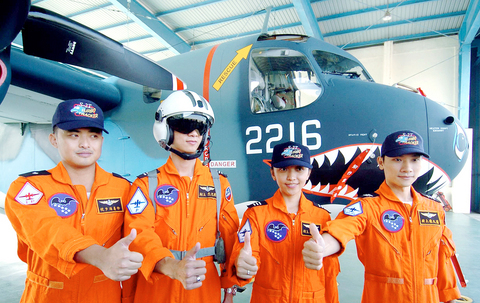The Ministry of National Defense stepped up to the plate to defend an arms procurement bill yesterday, inviting dozens of local and foreign journalists to military facilities in southern Taiwan to hear its case.
A naval official yesterday said that although China has more than 80 submarines, Taiwan's navy has only a fleet of obsolete S-2T Turbo Tracker sub-hunting aircraft that are unable to detect most of the submarines, and that was why the navy needed the more advanced P-3C Orion maritime patrol aircraft.
To give the public and the media a better understanding of the navy's anti-submarine warfare (ASW) capabilities, the navy yesterday invited reporters to visit a naval air base in Pingtung County, and displayed the S-2T aircraft and its weapon systems.

PHOTO: CHANG CHUNG-YI, TAIPEI TIMES
The navy has urged the public to support the purchase of 12 P-3Cs from the US -- one of three big-ticket items in a purchase that has been blocked for months by the pan-blue controlled legislature.
"The radar, infrared, magnetic anomaly detector and sonar systems fitted on the S-2T aircrafts to detect submarines and monitor unknown vessels are too old to efficiently complete the mission," said a commander of the S-2T force, Captain Wu Chun-wei (
He said the S-2T could only stay in the air for three hours and 20 minutes, with a top speed of 180 nautical miles per hour, which only allows them to operate in a small area.
He added that the S-2Ts have no air conditioning, no Global Positioning System (GPS) and few computer systems, and that pilots have to operate the aircraft manually -- all of which makes for a high-pressure ride for pilots.
"When S-2T pilots carry out missions in the summer, they are already sweating a lot before they get in the aircraft, but then when they fly in the winter, they must withstand the cold," Wu added.
He said most S-2T pilots consider the aircraft dangerous to fly.
In comparison, Wu said, the P-3C can stay in the air for 17 hours with a top speed of 405 nautical miles per hour.
The aircraft is equipped with a much better detection and weapon systems. And more importantly, the P-3C would be able to link to the military's command and control system, which would significantly enhance the navy's ASW capabilities.
He added that S-2Ts are unable to detect China's best submarines, such as the Ming-class, Song-class and Kilo-class submarines, as well as its nuclear-powered subs.
"We have found that China is obtaining much quieter submarines," Wu added.
He said only sustained patrols using advanced maritime patrol aircraft such as the P-3C can detect China's submarines when they are underwater around Taiwan.
He added that the navy has calculated that if it procures US P-3Cs, those aircraft could be used for more than 20 years.
Wu said the navy mainly patrols the waters northeast, southeast and east of Taiwan, and that 12 P-3Cs would be sufficient to protect the nation's waters.
Wu said that of the navy's 26 S-2Ts, only 16 of the 50-year-old aircraft are serviceable.
The navy's anti-submarine force includes 26 S-2Ts, eight 500MD helicopters and 18 S-70C helicopters. Taiwan purchased 32 used S-2Ts in 1976.

An essay competition jointly organized by a local writing society and a publisher affiliated with the Chinese Communist Party (CCP) might have contravened the Act Governing Relations Between the People of the Taiwan Area and the Mainland Area (臺灣地區與大陸地區人民關係條例), the Mainland Affairs Council (MAC) said on Thursday. “In this case, the partner organization is clearly an agency under the CCP’s Fujian Provincial Committee,” MAC Deputy Minister and spokesperson Liang Wen-chieh (梁文傑) said at a news briefing in Taipei. “It also involves bringing Taiwanese students to China with all-expenses-paid arrangements to attend award ceremonies and camps,” Liang said. Those two “characteristics” are typically sufficient

A magnitude 5.9 earthquake that struck about 33km off the coast of Hualien City was the "main shock" in a series of quakes in the area, with aftershocks expected over the next three days, the Central Weather Administration (CWA) said yesterday. Prior to the magnitude 5.9 quake shaking most of Taiwan at 6:53pm yesterday, six other earthquakes stronger than a magnitude of 4, starting with a magnitude 5.5 quake at 6:09pm, occurred in the area. CWA Seismological Center Director Wu Chien-fu (吳健富) confirmed that the quakes were all part of the same series and that the magnitude 5.5 temblor was

The brilliant blue waters, thick foliage and bucolic atmosphere on this seemingly idyllic archipelago deep in the Pacific Ocean belie the key role it now plays in a titanic geopolitical struggle. Palau is again on the front line as China, and the US and its allies prepare their forces in an intensifying contest for control over the Asia-Pacific region. The democratic nation of just 17,000 people hosts US-controlled airstrips and soon-to-be-completed radar installations that the US military describes as “critical” to monitoring vast swathes of water and airspace. It is also a key piece of the second island chain, a string of

The Central Weather Administration has issued a heat alert for southeastern Taiwan, warning of temperatures as high as 36°C today, while alerting some coastal areas of strong winds later in the day. Kaohsiung’s Neimen District (內門) and Pingtung County’s Neipu Township (內埔) are under an orange heat alert, which warns of temperatures as high as 36°C for three consecutive days, the CWA said, citing southwest winds. The heat would also extend to Tainan’s Nansi (楠西) and Yujing (玉井) districts, as well as Pingtung’s Gaoshu (高樹), Yanpu (鹽埔) and Majia (瑪家) townships, it said, forecasting highs of up to 36°C in those areas